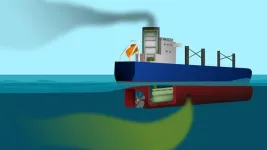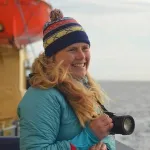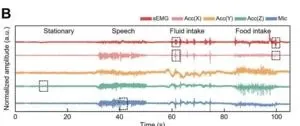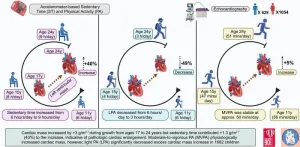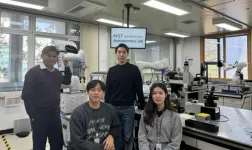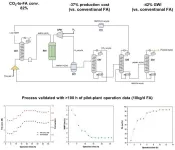(Press-News.org) Discharge from ships with so-called scrubbers cause great damage to the Baltic Sea. A new study from Chalmers University of Technology, Sweden, shows that these emissions caused pollution corresponding to socio-economic costs of more than EUR 680 million between 2014 and 2022. At the same time, the researchers note that the shipping companies' investments in the much-discussed technology, where exhaust gases are "washed" and discharged into the sea, have already been recouped for most of the ships. This means that the industry is now making billions of euros by running its ships on cheap heavy fuel oil instead of cleaner fuel.
“We see a clear conflict of interest, where private economic interests come at the expense of the marine environment in one of the world's most sensitive seas," says Chalmers doctoral student Anna Lunde Hermansson, who is one of the authors of the new study, published in Nature Sustainability.
The study has been prompted by the ongoing discussion on a potential ban of scrubber water discharge – where large volumes of polluted water is produced and discharged from the ships' exhaust gas cleaning systems. The issue is on the agenda at multiple levels within the International Maritime Organization (IMO) and is also being discussed at EU level as well as on national levels such as the Swedish Parliament, although a Swedish decision on a ban is yet to be made.
Anna Lunde Hermansson and Chalmers colleagues Erik Ytreberg and Ida-Maja Hassellöv have been researching the environmental impact of shipping for many years and are contributing with their expertise in both international and national contexts. In a previous study, for example, they have shown that more than 200 million cubic metres of environmentally hazardous scrubber water is discharged into the Baltic Sea annually and that scrubber discharge water accounts for up to 9 percent of the total emissions of certain carcinogenic polycyclic aromatic hydrocarbons (PAHs) into the Baltic Sea.
Excluding oil spill costs
In the new study, the Chalmers researchers calculated both the external costs of scrubber water discharge, and the financial balance sheets of over 3,800 vessels that invested in the scrubber technology. As for the costs associated with the degradation of marine ecosystems, the study shows that between the years 2014 and 2022, scrubber water discharges have polluted at a cost of over EUR 680 million in the Baltic Sea area. The calculations are based on models for willingness to pay to avoid marine environmental degradation, but according to the researchers, the estimates should be regarded as an underestimate. For example, direct costs associated with heavy fuel oil spills from ships using scrubbers are not included. The multi-million euro sum that it costs to clean up oil after ships have grounded and leak oil, for example Marco Polo on the Swedish coast of Blekinge last autumn, are not included in the calculations.
“If the scrubbers had not existed, no ships today would have been allowed to run on this dirty residual fuel. That is why the scrubber issue is highly relevant to push the shipping industry towards less negative environmental impact," says Lunde Hermansson.
Restrictions in several countries
In terms of the shipowner perspective, the researchers calculated the costs of installing and maintaining the scrubber systems, as well as the monetary gain from running the scrubber-equipped vessels on the cheaper and dirtier heavy fuel oil instead of the more expensive low-sulphur fuel alternatives. According to the calculations, the majority of the shipping companies that invested in scrubbers have already reached break even, and the total surplus by the end of 2022 for all of the 3,800 vessels, was EUR 4.7 billion. The researchers also note that more than 95 percent of the most common scrubber system (so-called open loop) are repaid within five years.
“From the industry's point of view, it is often stressed that shipping companies have acted in good faith by investing in technology that would solve the problem of sulphur content in air emissions and that they should not be penalised. Our calculations show that most investments have already been recouped and that this is no longer a valid argument," says Lunde Hermansson.
Recently, Denmark has decided to ban the discharge of scrubber water into so-called territorial waters, within 12 nautical miles of the coast. A number of countries around the world, such as Germany, France, Portugal, Turkey and China, have also adopted national bans or restrictions.
In Sweden, there is currently no general ban, although some ports, such as the Port of Gothenburg, have banned the discharge of scrubber water in their area.
“We now hope that the issue will also be given priority in the Swedish Parliament. This is a low-hanging fruit where we can reduce our negative impact on the vital marine environment,” says Lunde Hermansson.
More about the research:
The article "Strong economic incentives of ship scrubbers promoting pollution" has been published in Nature Sustainability. The study was conducted by Anna Lunde Hermansson, Ida-Maja Hassellöv, Tiia Grönholm, Jukka-Pekka Jalkanen, Erik Fridell, Rasmus Parsmo, Jesper Hassellöv and Erik Ytreberg. The researchers are active at Chalmers University of Technology, the Finnish Meteorological Institute and IVL, the Swedish Environmental Research Institute.
The research was funded by the Swedish Agency for Marine and Water Management, the Swedish Transport Administration and the EU's Horizon 2020.
Read previous press releases:
Research reveals large emissions from ship scrubbers
Marine environment at risk due to ship-emissions
More about scrubbers:
A scrubber can be described as a cleaning system for the exhaust gases formed during the combustion of heavy fuel oil, which has been the most common marine fuel since the 1970s. Seawater is pumped up and sprayed over the exhaust gases, which means that the emissions of sulphur compounds do not reach the air. The vessels thus comply with the requirements introduced by the International Maritime Organization, IMO, in 2020. The problem is that the water absorbs both the sulphur from the exhaust gases, which leads to severe acidification, and pollutants such as heavy metals and toxic organic compounds. The polluted scrubber water is then often pumped directly into the sea.
Since the mid-2010s, the number of vessels equipped with scrubbers has increased. In a study conducted in 2018, there were 178 ships with scrubbers in the Baltic Sea – today, researchers expect at least four times that. Globally, there are about 5,000 vessels, which corresponds to around five per cent of the total global fleet. Since it is mainly ships with high fuel consumption that invest in scrubbers, this five percent accounts for 25 percent of the global demand for heavy fuel oil.
A number of countries in the world have restricted or banned the discharge of scrubber water. about this in a report from the International Council on Clean Transportation: Global update on scrubber bans and restrictions - International Council on Clean Transportation (theicct.org)
For more information, please contact:
Anna Lunde Hermansson, PhD student, Department of Mechanics and Maritime Sciences, Chalmers University of Technology, Sweden,
anna.lunde.hermansson@chalmers.se, +46 31 772 18 66
Erik Ytreberg, Senior Researcher, Department of Mechanics and Maritime Sciences, Chalmers University of Technology, Sweden,
erik.ytreberg@chalmers.se, +46 31 772 27 49
Ida-Maja Hassellöv, Associate Professor, Department of Mechanics and Maritime Sciences, Chalmers University of Technology, Sweden,
ida-maja@chalmers.se, +46 31 772 31 39
The researchers speak Swedish and English and may be available for live and pre-recorded interviews. At Chalmers, we have podcasting studios and film equipment on site and can assist requests for TV, radio, or podcast interviews.
END
Millions in costs due to discharge of scrubber water into the Baltic Sea
2024-05-07
ELSE PRESS RELEASES FROM THIS DATE:
Bio-inspired materials’ potential for efficient mass transfer boosted by a new twist on a century-old theory
2024-05-07
The natural vein structure found within leaves – which has inspired the structural design of porous materials that can maximise mass transfer – could unlock improvements in energy storage, catalysis, and sensing thanks to a new twist on a century-old biophysical law.
An international team of researchers, led by the NanoEngineering Group at the Cambridge Graphene Centre, has developed a new materials theory based on ‘Murray’s Law’, applicable to a wide range of next-generation functional ...
Small pump for kids awaiting heart transplant shows promise in Stanford Medicine-led trial
2024-05-07
A small, implantable cardiac pump that could help children await heart transplants at home, not in the hospital, has performed well in the first stage of human testing.
The pump, a new type of ventricular assist device, or VAD, is surgically attached to the heart to augment its blood-pumping action in individuals with heart failure, allowing time to find a donor heart. The new pump could close an important gap in heart transplant care for children.
In a feasibility trial of seven children who received the new pump to support their failing hearts, six ultimately underwent heart transplants ...
Time flies, but your hands tell: Haut.AI cracks the age code with hand analysis
2024-05-07
Tallinn, Estonia – 7th May 2024, 10 AM CET – Haut.AI, a leader in responsible skincare artificial intelligence (AI) development, today announced a breakthrough research paper demonstrating the effectiveness of using hand images for accurate age prediction. This innovative approach offers a viable alternative to traditional facial photo methods and promotes fairer AI solutions.
The study, titled “Predicting human chronological age via AI analysis of dorsal hand versus facial images: A study in a cohort of Indian females,” shows that AI models trained on hand images achieve comparable accuracy to those using facial images, with an average error of ...
Babraham Institute receives £48M strategic investment from BBSRC for a four-year programme of work to promote lifelong health
2024-05-07
Following a quinquennial review by the Biotechnology and Biological Sciences Research Council (BBSRC), the Babraham Institute will receive £48m for the period 2024-2028 to advance research on the mechanisms that maintain the health of our cells, tissues and organs across the life course.
This work is key in driving BBSRC’s strategic research priorities around an integrated understanding of health, developing and applying transformative technologies and advancing our understanding of the rules of life.
As one of eight UK bioscience ...
Childhood sedentariness linked to premature heart damage – light physical activity reversed the risk
2024-05-07
An increase in sedentary time from childhood caused progressing heart enlargement, a new study shows. However, light physical activity could reduce the risk. The study was conducted in collaboration between the Universities of Bristol and Exeter, and the University of Eastern Finland, and the results were published in the prestigious European Journal of Preventive Cardiology.
Left ventricular hypetrophy refers to an excessive increase in heart mass and size. In adults, it is known to increase the risk for heart attacks, stroke, and premature death.
In the present study, 1,682 children ...
Parents’ watchful eye may keep young teens from trying alcohol, drugs: Study
2024-05-07
PISCATAWAY, NJ – Teenagers are less likely to drink, smoke or use drugs when their parents keep tabs on their activities--but not necessarily because kids are more likely to be punished for substance use, suggests a new study in the Journal of Studies on Alcohol and Drugs.
Researchers found that, contrary to common belief, parents’ “monitoring” does not seem to boost the odds of catching their kids using substances. However, when kids simply are aware that their parents are monitoring behavior, they avoid trying alcohol or drugs in the first place.
It is the fear of being caught, rather than actually being punished.
Many studies ...
A triumph of galaxies in three new images from the VST
2024-05-07
FOR IMMEDIATE RELEASE
Distant, far away galaxies. Interacting galaxies, whose shape has been forged by the mutual gravitational influence, but also galaxies forming groups and clusters, kept together by gravity. They are the protagonists of three new images released by the VLT Survey Telescope (VST).
VST is an optical telescope with a 2,6 diameter mirror, entirely built in Italy, that has been operating since 2011 at the European Southern Observatory’s (ESO) Paranal Observatory in Chile. Since 2022, the telescope has been fully managed by INAF through the National Coordination Centre for VST, ...
Smart labs for bespoke synthesis of nanomaterials are emerging
2024-05-07
In the early 20th century, the development of a catalyst for ammonia synthesis by the Haber-Bosch method took more than 10,000 experiments before it was successful. The development of new materials is a time-consuming and costly process from design to commercialization. However, in recent years, researchers have been working to shorten the development period by using artificial intelligence (AI). When combined with robots, it is possible to conduct material development research 24 hours a day, 365 days a year without human ...
The commercialization of CO2 utilization technology to produce formic acid is imminent
2024-05-07
CCU (Carbon Capture & Utilization), which captures CO2 and converts it into useful compounds, is crucial for rapidly transitioning to a carbon-neutral society. While CCS (Carbon Capture & Storage), which only involves CO2 storage, has entered the initial commercialization stage due to its relatively simple process and low operational costs, CCU has only been explored at the research level due to the complexity of conversion processes and high production costs of compounds.
Dr. Lee Ung's team at the Clean Energy Research Center ...
Multisite review shows serious adverse events occur frequently in outpatient care
2024-05-06
Embargoed for release until 5:00 p.m. ET on Monday 6 May 2024
Annals of Internal Medicine Tip Sheet
@Annalsofim
Below please find summaries of new articles that will be published in the next issue of Annals of Internal Medicine. The summaries are not intended to substitute for the full articles as a source of information. This information is under strict embargo and by taking it into possession, media representatives are committing to the terms of the embargo not only on their own behalf, but also on behalf of the ...
